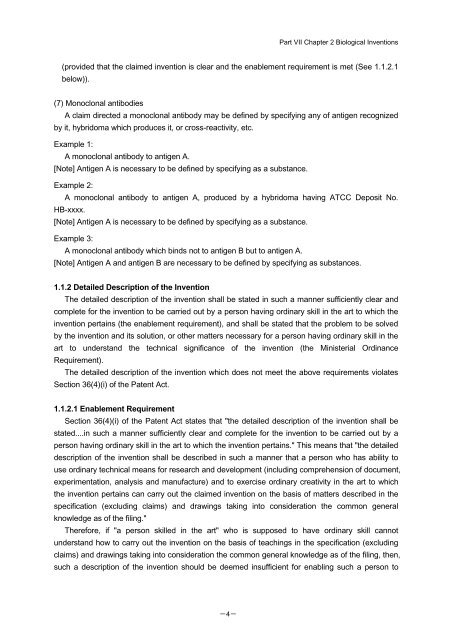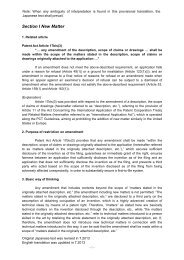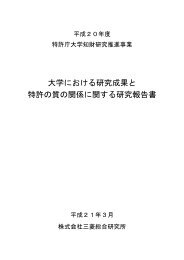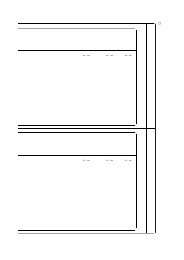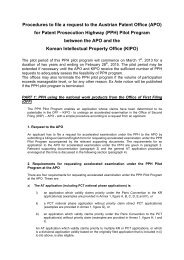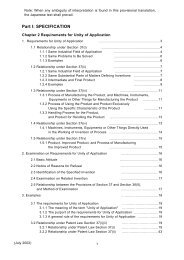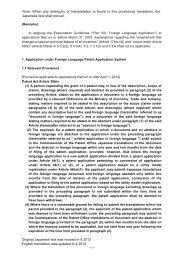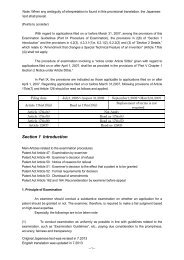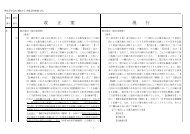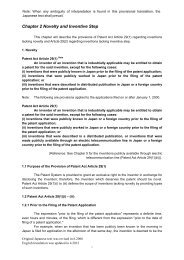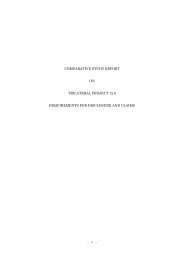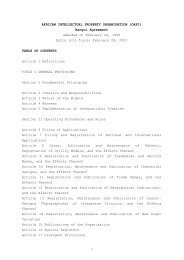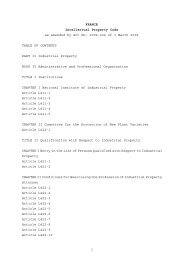Chapter 2 Biological Inventions - Japan Patent Office
Chapter 2 Biological Inventions - Japan Patent Office
Chapter 2 Biological Inventions - Japan Patent Office
You also want an ePaper? Increase the reach of your titles
YUMPU automatically turns print PDFs into web optimized ePapers that Google loves.
Part VII <strong>Chapter</strong> 2 <strong>Biological</strong> <strong>Inventions</strong><br />
(provided that the claimed invention is clear and the enablement requirement is met (See 1.1.2.1<br />
below)).<br />
(7) Monoclonal antibodies<br />
A claim directed a monoclonal antibody may be defined by specifying any of antigen recognized<br />
by it, hybridoma which produces it, or cross-reactivity, etc.<br />
Example 1:<br />
A monoclonal antibody to antigen A.<br />
[Note] Antigen A is necessary to be defined by specifying as a substance.<br />
Example 2:<br />
A monoclonal antibody to antigen A, produced by a hybridoma having ATCC Deposit No.<br />
HB-xxxx.<br />
[Note] Antigen A is necessary to be defined by specifying as a substance.<br />
Example 3:<br />
A monoclonal antibody which binds not to antigen B but to antigen A.<br />
[Note] Antigen A and antigen B are necessary to be defined by specifying as substances.<br />
1.1.2 Detailed Description of the Invention<br />
The detailed description of the invention shall be stated in such a manner sufficiently clear and<br />
complete for the invention to be carried out by a person having ordinary skill in the art to which the<br />
invention pertains (the enablement requirement), and shall be stated that the problem to be solved<br />
by the invention and its solution, or other matters necessary for a person having ordinary skill in the<br />
art to understand the technical significance of the invention (the Ministerial Ordinance<br />
Requirement).<br />
The detailed description of the invention which does not meet the above requirements violates<br />
Section 36(4)(i) of the <strong>Patent</strong> Act.<br />
1.1.2.1 Enablement Requirement<br />
Section 36(4)(i) of the <strong>Patent</strong> Act states that "the detailed description of the invention shall be<br />
stated....in such a manner sufficiently clear and complete for the invention to be carried out by a<br />
person having ordinary skill in the art to which the invention pertains." This means that "the detailed<br />
description of the invention shall be described in such a manner that a person who has ability to<br />
use ordinary technical means for research and development (including comprehension of document,<br />
experimentation, analysis and manufacture) and to exercise ordinary creativity in the art to which<br />
the invention pertains can carry out the claimed invention on the basis of matters described in the<br />
specification (excluding claims) and drawings taking into consideration the common general<br />
knowledge as of the filing."<br />
Therefore, if "a person skilled in the art" who is supposed to have ordinary skill cannot<br />
understand how to carry out the invention on the basis of teachings in the specification (excluding<br />
claims) and drawings taking into consideration the common general knowledge as of the filing, then,<br />
such a description of the invention should be deemed insufficient for enabling such a person to<br />
-4-


